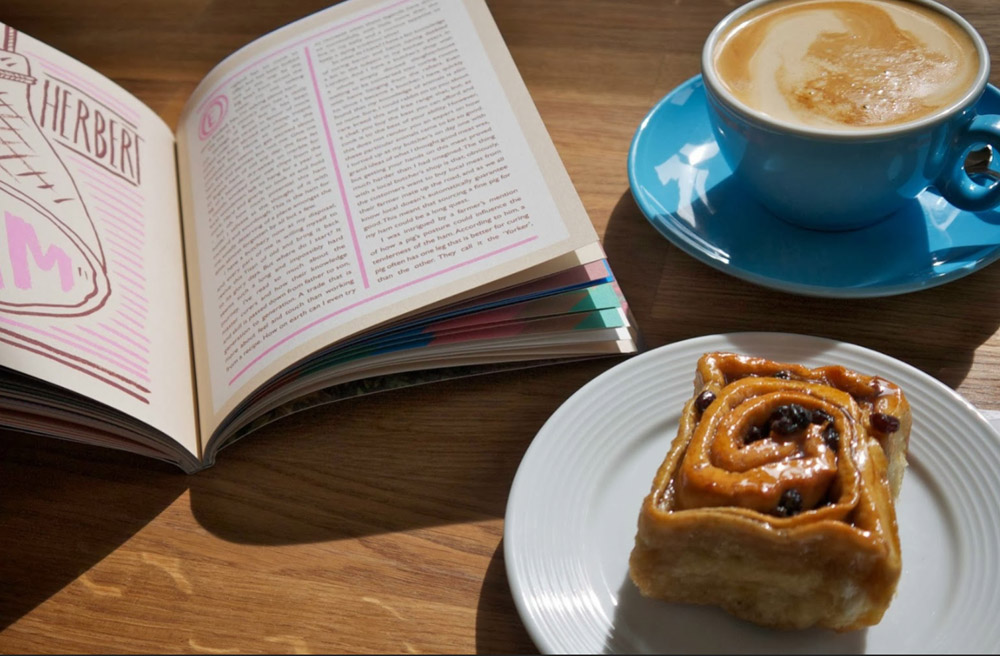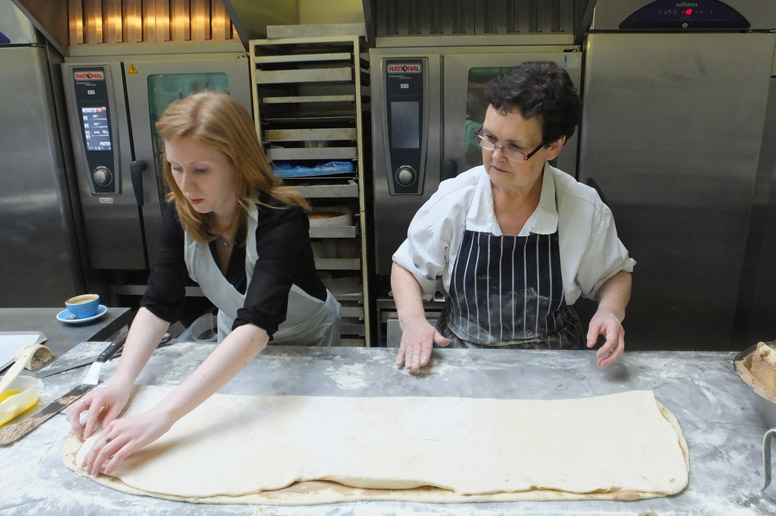Between a plump lump of dough, what looks like a heavy-duty pasting brush and a cauldron of currants, there’s me. Wearing a fetching plastic apron, I’ve just watched Gill Abbs create a batch of the famous Fitzbillies Chelsea buns in about three minutes flat. Now it’s my turn.
Incredibly, Gill has been baking these syrupy swirls of perfection since 1972, made to a closely-guarded family recipe. It’s this respect for tradition that people love about Fitzbillies, which is why I’m a tad nervous as I start rolling out the dough, Gill looking on wisely.
I’ve been invited behind the scenes at Fitzbillies on the back of a new book, A Slice of Britain. Written by Caroline Taggart, it’s a jaunt around the country by cake, unravelling the secrets and stories behind local bakes, like the Bath bun and the Yorkshire curd tart – and of course our own, albeit adopted, signature bake, the Chelsea bun.
“Chelsea bun is a name given to any bun with that curled-up, snail-like shape,” says Alison Wright, who runs Fitzbillies with husband Tim Hayward. “They’re often quite dry, without the sticky syrup over the top, so people are astonished by the lusciousness of our Chelsea buns: they’re quite a di fferent beast.”
First dreamt up as a sugary treat for the Georgian nobility, the Chelsea bun was adopted by bakeries everywhere, especially in university towns full of hungry students.
“A lot of people discover them as undergraduates, when they’re still able to eat enormous quantities of cake and get away with it!” laughs Alison. “Or after rowing, when they need lots of energy. It’s not just about ‘gown’, though; the town has an important role as well. When my mum took us into town shopping on a Saturday we would always come to Fitzbillies for a bun. We still get a lot of people doing that today.”

It’s thanks to Alison’s fond associations that Fitzbillies still stands today. In 2011, the bakery unexpectedly closed after nearly 90 years. Even Stephen Fry took to Twitter to vent his surprise, exclaiming: “No! No! Say it ain’t so – not Fitzbillies? Why I tweeted a pic of one of their peerless Chelsea buns but a sixmonth ago”.
So it was that Alison picked up the news, and half a year later she and Tim were behind the counter, restoring the bakery to its former glory.
Today, it’s a bright, bustling place which still honours its past, with many original recipes remaining firmly intact.
“We loved the brand and the heritage,” explains Alison, “still, we had to identify the things we wanted to continue and the things that weren’t helping the business and had to change. People are used to better food now, and what passed as a good cake in the 1950s during rationing won’t do today. And people want di fferent things, like carrot cake, brownies… So we’ve developed the range, as well as keeping some things exactly the same.
“The Chelsea buns were absolutely to be kept,” she adds. “Any business is lucky to have a famous product that people keep coming back for.”
Fitzbillies also do wedding cakes, birthday cakes and catering for college balls. “We made Stephen Hawking’s birthday cake this year – it was a dark chocolate cake with gold stars on it in a sort of galaxy design.”
Meanwhile, my own batch of buns has been browning in the oven and is ready to come out. Incredibly, they look ok. Gill even asks which ones were mine and which were hers – maybe she’s just being polite. (In case you’re wondering how these spirally buns get their distinctive square shape, it’s by arranging them on the baking tray in twos, so they squish together as they bake and rise.)
Most importantly, they taste wonderful: warm, sweet, with a satisfying outer crunch, it’s obvious why these buns have amassed such a following. Here’s to the next 90 years of Fitzbillies buns.
:: A Slice of Britain by Caroline Taggart, £14.99, is out 3 March 2014.

